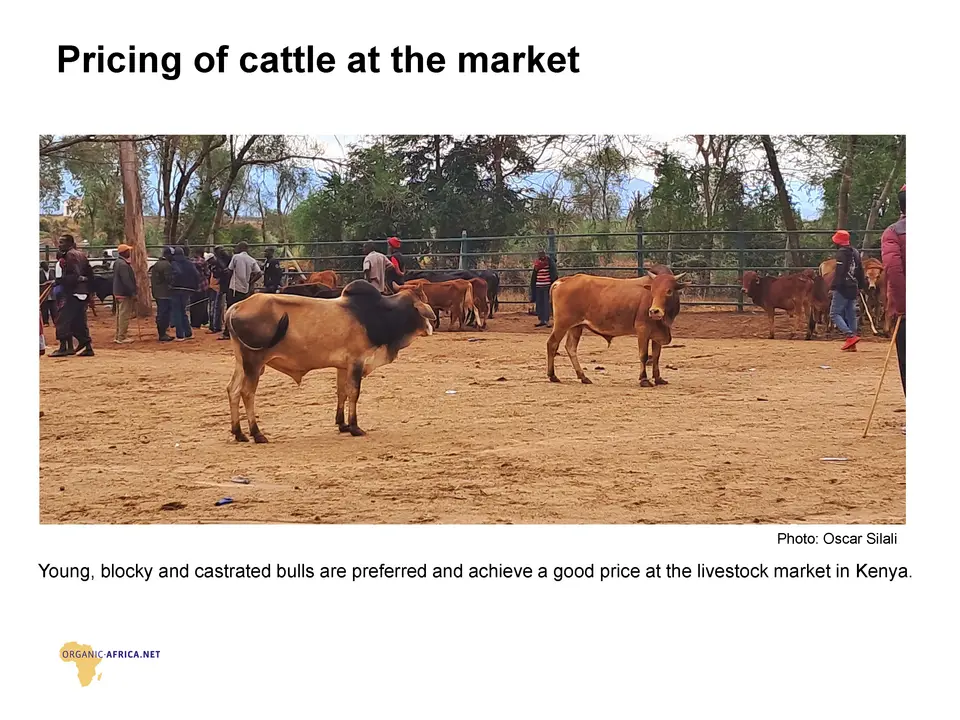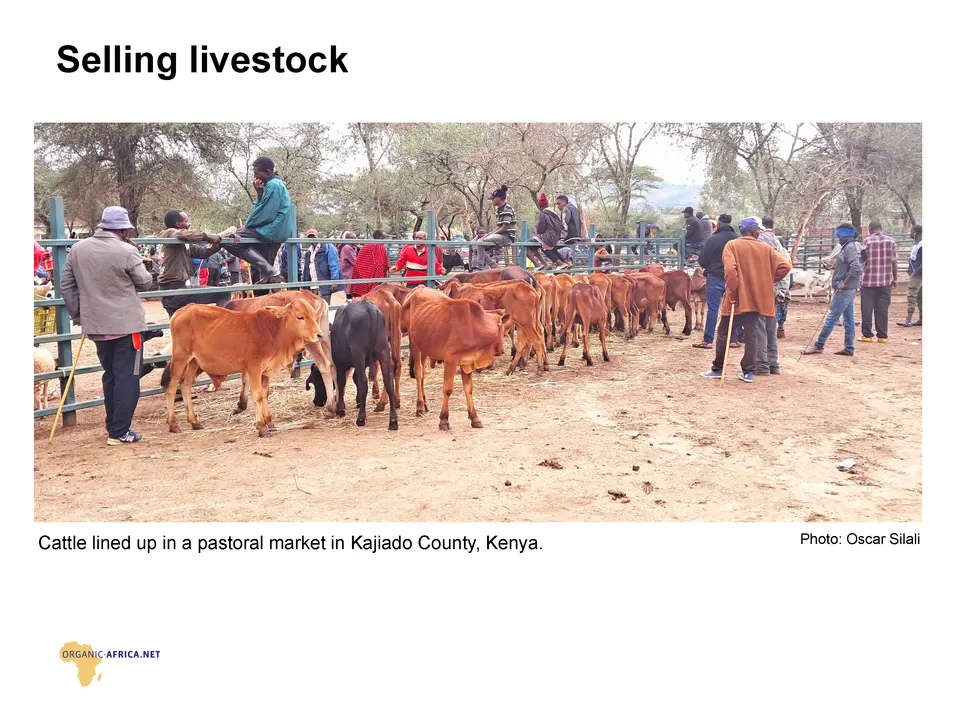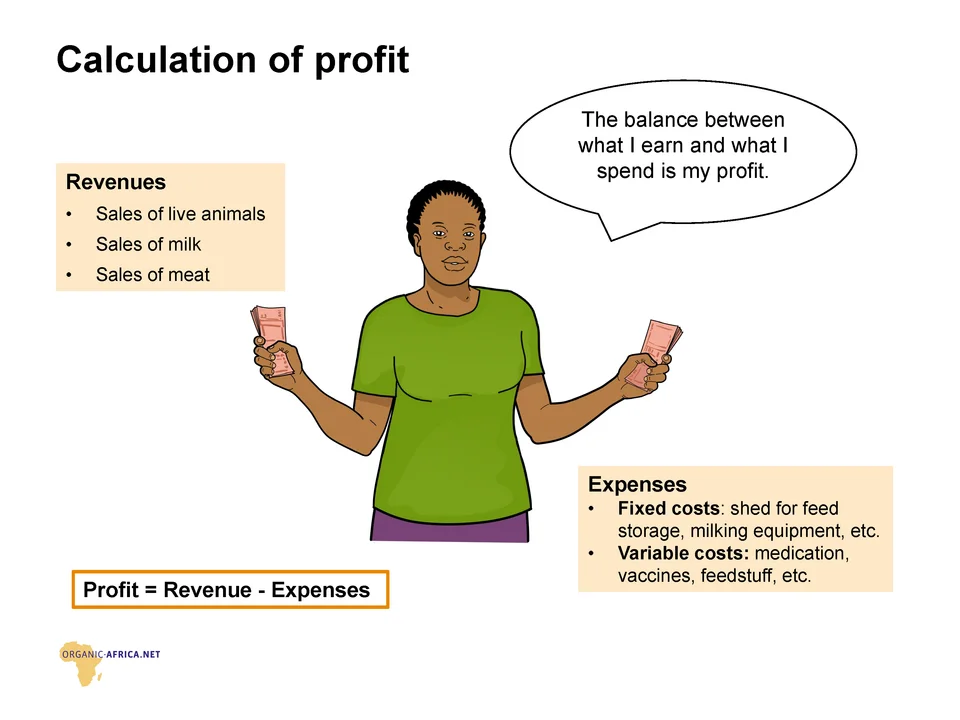Economics and Organic Certification
The following chapter delves into the economics of organic certification in livestock farming, exploring various revenue streams such as meat, milk, dairy products, leather, or manure. It details decision factors for selling animals, emphasizing market monitoring, animal selection, and timing. Additionally, the chapter discusses marketing strategies for organic products, highlighting their nutritional, environmental, and welfare benefits, while stressing the importance of understanding market dynamics and maintaining comprehensive record-keeping systems to assess profitability and make informed business decisions.
If you want to delve deeper into economic topics at farm level, go to chapter “Farm Management”.
Products for revenue
There are several options on how to generate a revenue from livestock:
- Meat: One main source of income for cattle farms comes from selling the meat of slaughtered cattle or from selling slaughter-ready animals to customers or traders. If the meat can be stored well, it makes sense to slaughter your own animals yourself to generate a higher profit per kg of meat than if the animals are sold alive. However, it depends on the slaughtering and storage infrastructure on the farm and on whether the customers prefer to buy meat or living animals.
- Milk: If there is a market for (organic) milk, the female animals can be milked and the milk sold. Milk is sold either directly to consumers, through a cooperative group, a dairy factory or a trader. When selling milk, it is particularly important to ensure very good hygiene. Selling milk requires appropriate cooling infrastructure to ensure impeccable milk quality.
- Cheese and other processed dairy products: Many countries or communities with milk production have a tradition of milk processing on the farm. Processing of milk to cheese, curd cheese, yoghurt or other products increase the value produced on the farm and results in products with a longer shelf life and transportability. However, milk transformation on the farm requires appropriate facilities, equipment and knowledge.
- Leather: In case of on-farm slaughtering, the leather of cattle can also be sold.
- Manure: Manure is a valuable organic fertilizer and helps to improve poor soils. In contrast to other parts of the world, over-fertilization is not often a problem in Sub-Saharan Africa, while unfertilized soils are widespread. Nevertheless, soils can become oversaturated with nutrients if many animals are kept in one place. Overfertilised soils will lose nutrients into the groundwater or surface waters which can harm the environment and contaminate drinking water. As a general rule, organic farms should only keep as many cattle as the farm can feed, and whose manure can be used on the farm. If a farm has too much manure, it makes sense to sell the surplus manure to surrounding farmers.
- Services: Another possible source of income is offering services to other farmers, such as tilling fields with oxen. Transporting goods and people with the help of cattle on a wagon can also generate income.
Decision factors when selling animals
- Buyers can have different reasons for buying cattle; they may want them for a gift, dowries, breeding, milk production or fattening; or for selling to a butcher or abattoir. Due to the possible different uses of cattle, from a seller's perspective, it is important to think carefully about which animals to sell and when to sell them to get a good price at the market. The following factors may be useful in the decision process:
- Monitor market prices: If feed prices are very high or market prices for milk are low, but (cow) meat prices are high, it may make sense to reduce the herd size and sell or slaughter more animals than usual.
- Day of sale: If an animal is offered at a market, make sure that it makes as good an impression as possible. It should be well-fed (body condition score 3 or above), clean, free of ticks or parasites, free of injuries, alert and attentive.
- Selection of animals for sale: First, animals are sold or slaughtered that are not breeding animals. Female animals with good properties should be kept because they have a high production potential and will give the best offspring. They are the baseline of a successful farm!
- Age and body condition: Animals aged between 2 and 4 years are usually the best to sell, while particularly young or old animals will fetch lower prices. Animals with good body condition are sold at higher prices. The question is whether it is worth investing in an animal (feed, effort, space, etc.) until it generates a higher price on the market. If the costs to be invested are higher than the potential price increase, it makes more sense to sell the animals young at a lower price.
- Calves: Calves should be sold at the age of 12 weeks at the earliest. Before then, they do not have a sufficiently developed immune system and a change of location often leads to sick, weak calves and costs (medicine) and losses (poor growth and development) for buyers. The same applies when calves are bought from other farms: one should not buy calves younger than 12 weeks.
- Sell lactating cows: If cows are sold for milk production, animals in early lactation usually get the best price, as the daily amount of milk that the cows produce sinks over the duration of lactation. Alternatively, a visibly pregnant heifer may get a good price, too. On the other side, the earlier a cow is sold, the more income from milk is not realised. This dilemma requires to weigh up whether, for example, market prices are better at the moment for milk or meat or cows, and from what the farm benefits more.
Marketing
Promoting and presenting farm products well to customers is of special importance for (certified) organic products, since often the prices for such products are higher due to certification costs and consumers looking for the specific quality are addressed. The consumers/buyers should see a benefit in buying organic products over non-organic products. These benefits should be clearly communicated.
Benefits of organic cattle products
- Nutritional value: The diet of cattle has an impact on the nutritional value of their products. Grass-fed cattle produce meat and milk with a higher content of Omega-3 fatty acids which are healthy for humans.
- Chemical and antibiotic-free products: Organically raised animals must not be fed feed that has been sprayed with synthetic chemicals during cultivation or storage. The meat or milk from organically raised animals is therefore free from contamination with such chemicals. Also, milk from organic cows is not contaminated with antibiotics or growth hormones.
- Environment and climate change: Livestock production on organic farms is adapted to the local conditions and to the farm resources. Site-adapted animal density, feeding the animals with farm-own roughage, and implementing site-adapted grazing strategies can contribute to less soil erosion, increased carbon sequestration, control bush encroachment, and overall climate mitigation.
- Animal welfare: Organic animal husbandry aims at providing the best possible conditions for the animals by avoiding pain, prolonged hunger or thirst, discomfort and stress, injuries and diseases, as well as enabling natural behaviour. Furthermore, the livestock breeds used in organic production aim at a moderate meat and milk production with healthy, long-living and productive animals. Overall, organic animals experience better animal welfare which also positively impacts human welfare.
Besides that, it is important that the market opportunities and requirements are well-understood. The following questions may help to better understand the market situation and be able to better evaluate market options:
Knowing to whom and what I want to sell:
- Who are the potential buyers of my products? Consumers or traders, retailers or cooperative groups?
- Which products do I sell?
- How much produce can I make available?
- Of which quality are my products?
- Do I provide constant supply or not?
- Can I react to higher/lower demand of products? E.g. are larger amounts for times of festivities planned?
- For which price do I want to sell my products?
- What promotion activities can I implement to build up a good network of buyers and establish a solid farmer-consumer relationship?
Knowing and comparing the market opportunities:
- Is the market stable (continuous supply and sale of products)?
- What is the relation between demand and supply?
- Are the prices fair and constant?
- How will the market evolve in the future?
- Who are the other competitors in this market and how will they evolve in the future? What implications does this have on my own business?
- What barriers to market access do I face?
Comprehensive information about marketing of organic products are provided in the manual “Marketing and Trade”.
Record keeping
A solid record-keeping system is part of every successful livestock business. The information gained from record keeping supports…
- … the evaluation of the efficiency of the farm.
- … identify success and failures.
- … financial planning decisions.
- … helping determine the profitability of farm activities.
- … detecting systematic health, feeding and management issues.
- … to assist decisions in farm and animal management.
- … providing data for government administrative and extension purposes.
- … monitoring of farm operations farm during time of absence (record kept by workers).
Other benefits of record keeping could be added and what type of records are relevant for a farm is very individual. Which records should be kept on a farm depends on the farm size, the herds size, and the farmer preferences of the records to be kept.
Records can be kept in a book or digitally on the smartphone or the computer. For digital record keeping, several apps can be found online.
Types of records
- Identification of cattle: identification name/number, date of birth, gender, breed, pedigree, colour, type of cattle …
- Financial records: expenditure records, sales record …
- Production records: milk yield, percentage of protein and fat, somatic cells count, animal weight gain, reproductive records, date of heats, date of breeding, date of calving, date of weaning, weaning weight of calf …
- Health records: vaccinations, treatments, diseases …
- Records of agricultural inputs on pastures: fertilisers, seeds, minerals …
- Records of animal feeds: inventory of all types of animal feed, use records …
- Daily farm records: important daily activities and events that happen on the farm …
- Records of farm implements and equipment: inventory of all farm equipment …
- Workers and vehicle records: workers and labour record, petrol, oil, repairs, vehicles …
Is the business profitable?
The profit of a business can be calculated with a simple formula. Data from record keeping can be used for the calculation. The formula for this is:
Profit = Revenue (sales) – Expenses (fixed and variable costs)
In order to survive financially, a business must generate profits, i.e. it must earn more than it spends.
On the one hand, this calculation helps to estimate whether a business is profitable and whether it is doing well (profit is high enough) or whether something should be changed (profit is low or making a loss). If the profit is low or making a loss for a longer period of time, the business cannot survive financially.
The same calculation also helps in planning when starting up a cattle business and you want to know, if this could be a profitable business for you or not. For this purpose, the expenses and revenues must be estimated. It is helpful if different scenarios are calculated, where potential risks and opportunities are included.
Best case scenario: e.g. the demand for the product is high and a good price can be achieved, while production prices are stable.
Worst case scenario: e.g. only a fraction of the product can be sold because a buyer who has regularly bought cattle is now buying cattle from another farmer at a lower price. Due to a drought, the farmer has to ask a higher price, as he had to buy large quantities of feed at a high price.
Expenses = Fixed costs + variable costs
Going back to the formula above to calculate the profit, one first needs to calculate the expenses. The expenses include the fixed costs and the variable costs. Fixed costs are expenses that remain constant and are not dependent on the level of outputs. Variable costs vary over time and are dependent on activities, services or level of production.
Examples for expenses and revenues
Infrastructure and facilities (fixed costs)
- Animals: purchase of livestock to start
- Housing: shed, giving shade and protection from rain to the animals, litter material
- Pasture and fences: material for fencing
- Feeding and drinking equipment: troughs, water reservoir, borehole
- Feed: storage area for feeding stock, mineral feed, roughage stock
- Milking equipment: cleaning material, teat disinfection, can for the milk and potentially automatic milking system, milk storage
- Other equipment and machinery, such as tractors, ploughs etc.
- Depreciation: This includes the annual depreciation expense associated with the wear and tear of assets like buildings and equipment.
Other fixed costs
- Rent, land costs
- Interest payments on loans
- Electricity and water
- Insurance
- Building and equipment maintenance
Variable costs: ongoing operational costs
- Feeding and drinking: water, purchase of forage, production of feed, mineral feed
- Breeding: costs for insemination
- Bedding and litter material
- Veterinary care: vaccinations, visits and medication costs, pest control
- Labour
- Transportation costs
- Slaughter and processing
- Marketing
- Technical advice: extension services, organic groups
Revenues
- Price for sold live animals
- Sales: meat, milk, leather
- Manure sold as fertiliser
- Service: draught animal work for other farmers
- Service: transport
Other benefits: non-operating revenues
In addition to the income from sales, cattle can also bring other benefits to a farmer and his family. These are not included in the profit calculations as they do not directly lead to a profit. But they should also be taken into account.
- Manure used as fertiliser on the farm resulting in better crop yields
- Draught animal work (own fields)
- Transport
- Improved nutrition
- Gains from investments
Organic certification
Find more information on organic certification in animal production under “organic certification and marketing”.
Find more general information about organic certification in this chapter: Why and how to get organically certified?



 tap and then scroll down to the Add to Home Screen command.
tap and then scroll down to the Add to Home Screen command.